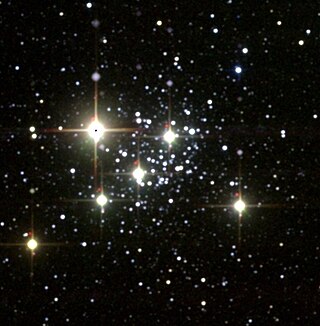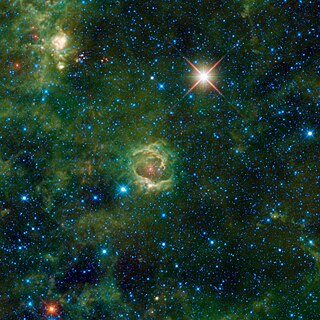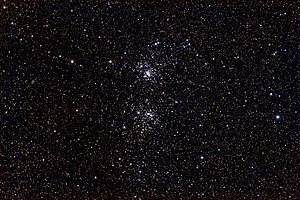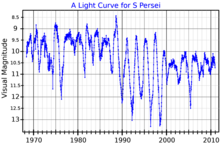
Scutum is a small constellation. Its name is Latin for shield, and it was originally named Scutum Sobiescianum by Johannes Hevelius in 1684. Located just south of the celestial equator, its four brightest stars form a narrow diamond shape. It is one of the 88 IAU designated constellations defined in 1922.

Red supergiants (RSGs) are stars with a supergiant luminosity class and a stellar classification K or M. They are the largest stars in the universe in terms of volume, although they are not the most massive or luminous. Betelgeuse and Antares A are the brightest and best known red supergiants (RSGs), indeed the only first magnitude red supergiant stars.

KY Cygni is a red supergiant of spectral class M3.5Ia located in the constellation Cygnus. It is approximately 4,700 light-years away.

Phi Cassiopeiae is a multiple star in the constellation Cassiopeia with a combined apparent magnitude of +4.95. The two brightest components are A and C, sometimes called φ1 and φ2 Cas. φ Cas A is an F0 bright supergiant of magnitude 4.95 and φ Cas C is a 7.08 magnitude B6 supergiant at 134".

A yellow hypergiant (YHG) is a massive star with an extended atmosphere, a spectral class from A to K, and, starting with an initial mass of about 20–60 solar masses, has lost as much as half that mass. They are amongst the most visually luminous stars, with absolute magnitude (MV) around −9, but also one of the rarest, with just 20 known in the Milky Way and six of those in just a single cluster. They are sometimes referred to as cool hypergiants in comparison with O- and B-type stars, and sometimes as warm hypergiants in comparison with red supergiants.

V354 Cephei is a red supergiant star located within the Milky Way. It is an irregular variable located over 13,000 light-years away from the Sun. It has an estimated radius of 1,139 solar radii. If it were placed in the center of the Solar System, it would extend to between the orbits of Mars and Jupiter.

Westerlund 1 is a compact young super star cluster about 3.8 kpc away from Earth. It is thought to be the most massive young star cluster in the Milky Way, and was discovered by Bengt Westerlund in 1961 but remained largely unstudied for many years due to high interstellar absorption in its direction. In the future, it will probably evolve into a globular cluster.

MY Cephei is a red supergiant located in open cluster NGC 7419 in the constellation of Cepheus. It is a semiregular variable star with a maximum brightness of magnitude 14.4 and a minimum of magnitude 15.5.

A hypergiant (luminosity class 0 or Ia+) is a very rare type of star that has an extremely high luminosity, mass, size and mass loss because of its extreme stellar winds. The term hypergiant is defined as luminosity class 0 (zero) in the MKK system. However, this is rarely seen in literature or in published spectral classifications, except for specific well-defined groups such as the yellow hypergiants, RSG (red supergiants), or blue B(e) supergiants with emission spectra. More commonly, hypergiants are classed as Ia-0 or Ia+, but red supergiants are rarely assigned these spectral classifications. Astronomers are interested in these stars because they relate to understanding stellar evolution, especially star formation, stability, and their expected demise as supernovae. A common example of a hypergiant is UY Scuti, although being a supergiant UY Scuti is considered a hypergiant by some people.

HD 168607 is a blue hypergiant and luminous blue variable (LBV) star located in the constellation of Sagittarius, easy to see with amateur telescopes. It forms a pair with HD 168625, also a blue hypergiant and possible luminous blue variable, that can be seen at the south-east of M17, the Omega Nebula.

PZ Cassiopeiae is a red supergiant star located in the constellation of Cassiopeia, and a semi-regular variable star.

Westerlund 1 W26 or Westerlund 1 BKS AS is a red supergiant located at the outskirts of the Westerlund 1 super star cluster. It is one of the largest known stars and the most luminous supergiant stars discovered so far with radius calculated to be in excess of a thousand times the solar radius, and a luminosity of over 200,000 times the solar luminosity. If placed at the center of the Solar System, its photosphere would engulf the orbit of Jupiter.
AH Scorpii is a red supergiant variable star located in the constellation Scorpius. It is one of the largest stars known by radius and is also one of the most luminous red supergiant stars in the Milky Way.

10 Persei is a blue supergiant star in the constellation Perseus. Its apparent magnitude is 6.26 although it is slightly variable.

HR 5171, also known as V766 Centauri, is a yellow hypergiant in the constellation Centaurus. It is said to be either an extreme red supergiant (RSG) or recent post-red supergiant (Post-RSG) yellow hypergiant (YHG), both of which suggest it is one of the largest known stars. The star's diameter is uncertain but likely to be between 1,100 and 1,600 times that of the Sun, while its distance is 3.6 kpc from Earth. According to a 2014 publication, the star is a contact binary, sharing a common envelope of material with a smaller yellow supergiant and secondary star, the two orbiting each other every 1,304 ± 6 days.

RS Persei is a red supergiant variable star located in the Double Cluster in Perseus. The star's apparent magnitude varies from 7.82 to 10.0, meaning it is never visible to the naked eye.

BC Cygni is a red supergiant and pulsating variable star of spectral type M3.5Ia in the constellation Cygnus.

XX Persei is a semiregular variable red supergiant star in the constellation Perseus, between the Double Cluster and the border with Andromeda.

Westerlund 1-20 (abbreviated to Wd 1-20 or just W20) is a red supergiant (RSG) located in the Westerlund 1 super star cluster. Its radius was calculated to be around 965 solar radii (6.72 × 108 km, 4.48 au), making it one of the largest stars discovered so far. This corresponds to a volume 899 million times bigger than the Sun. If placed at the center of the Solar System, the photosphere of Westerlund 1-20 would almost reach the orbit of Jupiter.

Westerlund 1-243 or Wd 1-243 is a luminous blue variable (LBV) star undergoing an eruptive phase located within the outskirts of the super star cluster Westerlund 1. Located about 13,400 ly (4,100 pc) from Earth, it has a luminosity of 0.73 million L☉ making it one of the most luminous stars known.
















